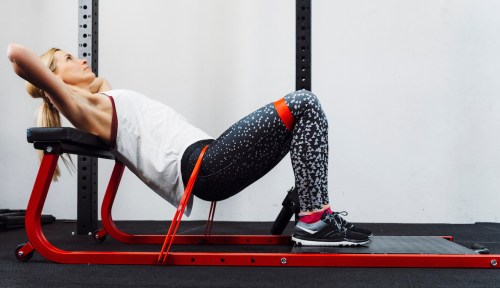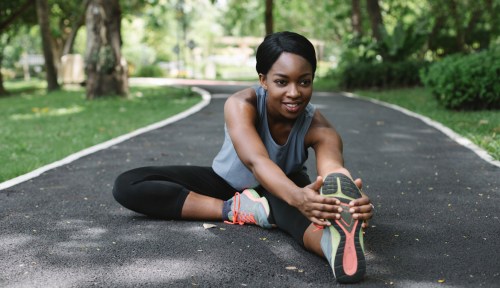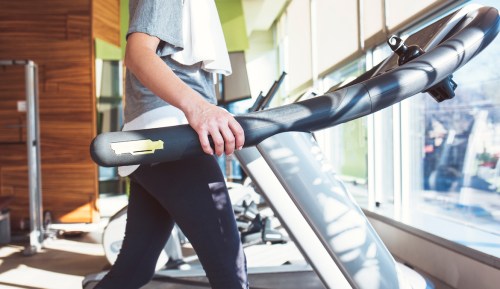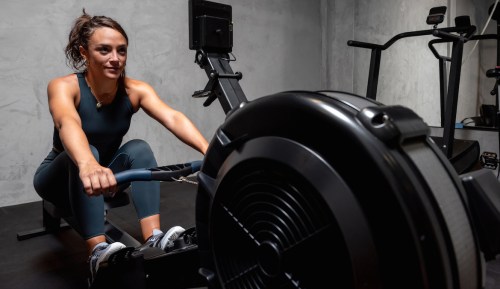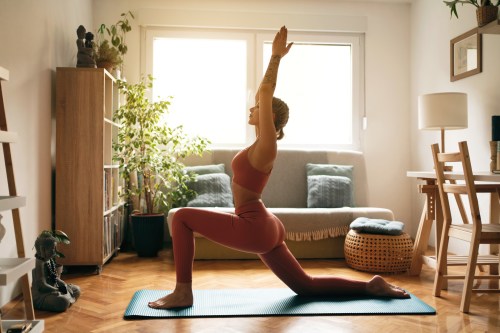Judy Gymgoer loves doing glute bridges. They’re a staple in her Pilates and barre classes, and she finds they consistently fire up her backside. But recently, she’s been seeing all the fitfluencers on TikTok praising the benefits of hip thrusts instead. It’s got her questioning her longtime approach. Now she’s wondering, when it comes to the glute bridge vs hip thrust, which exercise actually gives your butt the better workout?
Experts in This Article
certified personal trainer
It’s an understandable question since glute bridges and hip thrusts look pretty darn similar. Both have you hinging at the hips, lifting your butt up and down. For glute bridges, you lie with your back on the floor (with knees bent and feet on the ground), then lift and lower from there. In hip thrusts, meanwhile, you do the same basic motion, but you set up for it by placing your shoulders on a raised platform like a bench so that your glutes are in mid-air the entire time as they raise up and lower down past your shoulders.
Both exercises work the same muscle groups, says Sarah Pope, CPT, a trainer with Life Time fitness clubs in the Washington, D.C., area. The main character will always be your gluteus maximus, and your hamstrings, other glute muscles (the medius and minimus), adductor longus (along the inner thighs), and your core will all play a supporting role.
You can also progress both exercises with a variety of variations, like adding a miniband around your thighs, lifting up one foot to make it a single-legged challenge, or putting some free weights on top of your hips for a heavier load.
Yet, despite all these similarities, you don’t get the exact same thing out of glute bridges and hip thrusts—there are a few important differences. Here, we break them down so you (and Judy) can decide exactly which move will serve you best during your next workout.
The benefits of glute bridges
There are good reasons why glute bridges are a tried-and-true staple in so many fitness classes.
They’re beginner-friendly
Nearly anyone can do a glute bridge. Because you’re lying on the floor, you’ve only got a limited range of motion with a small chance of making mistakes. “They can be really helpful in helping someone control the positioning of their pelvis relative to their rib cage,” says Kristie Larson, CSCS, founder of Tension, a women’s-only strength training gym in New York City.
You’re unlikely to get injured
Since it’s such a gentle movement with the floor as your start and end point, a glute bridge is a super safe exercise to do. “It's not intense. It's not high-impact,” Pope says. Though some people might feel a little lower back discomfort, she says, that’s usually easy to avoid by better engaging the core or keeping the hips a little lower. And, over time, doing more glute bridges will increase your core strength, making that back pain even less likely, she adds.
Zero equipment is required
Although you can add some dumbbells or a mini-band to this move to amp up the challenge, the basic glute bridge doesn’t require anything but enough floor space to lie down. This makes it great for home workouts or a quick glute challenge on-the-go.
The benefits of hip thrusts
So why is social media so obsessed with hip thrusts these days? Well, here are three major perks.
They work a bigger range of motion
Because your shoulders are elevated and your hips dip down further—rather than ending at the floor—you’re working in a bigger range of motion in a hip thrust than in a glute bridge. “This will really dig deeper within those muscles to recruit more muscle fibers. You're working not only the concentric but also the eccentric a little bit more,” Pope says, referring to the fact that our muscle fibers will contract more while shortening as we lift the hips (concentric) and while lengthening as we lower the hips (eccentric). This additional challenge “is ultimately going to mean that you have more potential to build strength,” Larson says.
You can lift heavier weights
One way to progress both glute bridges and hip thrusts is to put some free weights on the top of your hips. But if you really want to lift heavy, you’re going to need to do a hip thrust. “It's hard to continue to load a glute bridge because then you end up with a lot of pressure in your neck since your head is [lower down] on the floor,” Larson says. Additionally, if you want to use a barbell or a loaded EZ bar (which Larson recommends), the plates will get in the way on a glute bridge when the hips lower all the way to the floor.
They challenge your balance and control
Throughout a hip thrust, your feet and shoulders are your only anchor points. “You have a little bit more balance incorporated into the movement,” Pope says. “You have to focus not only on driving your hips up towards the ceiling, but really controlling the weight coming down, not having the floor as your breaking point.” This provides an extra challenge to all the stabilizer muscles in the core in particular, she adds.
How to choose between the glute bridge vs hip thrust
If you’re pretty new to fitness, or just still getting the hang of that hinging motion at the hip, glute bridges are your best bet to build foundational glute strength in a safe way. “As someone who wants to start training the lower body, that can be a really friendly and accessible place to start,” Larson says. Glute bridges are also a great warm up to gently get your glutes and hamstrings activating before you start a heavier strength training session, Pope adds.
But once you’re ready to progress, hip thrusts will give you more bang for your buck, allowing you to build more strength and muscle mass. “Anyone who’s looking to increase glute strength, power, or just intensity overall, the hip thrust would be best,” Pope says. Out of all your options for glute exercises, she says the hip thrust is one the best around for increasing glute size.
Just know that hip thrusts can be trickier to pull off correctly. “If someone doesn't already have really good control of their trunk and keeping their rib cage and their pelvis aligned, there's a risk that they're going to stress their lower back,” Larson says. Pope adds that she sometimes sees people crank their neck back on the bench, throwing off the alignment of their spine. Other times, she sees people power the movement through their quads instead of using those posterior chain muscles in the back of their thighs and hips. “And,” she adds, “it is not the most comfortable position when you are going for max strength,” since the barbell can dig into your hip bones. She suggests using a towel or hip pad to cushion that weight.
The, ahem, bottom line
At the end of the day, more important than deciding between the glute bridge vs hip thrust is simply working your backside regularly. “Unfortunately, our glutes and hamstrings are very underworked muscle groups,” Pope says. “So really making sure that we're getting that posterior chain lit up as much as possible is going to supplement what we do on a day-to-day basis.”
Just go with the challenge that’s best suited to your current fitness level—no matter what you’re seeing on social media. “Like with anything,” Larson says, “it's about finding what's most appropriate for where you are now.”
Sign Up for Our Daily Newsletter
Get all the latest in wellness, trends, food, fitness, beauty, and more delivered right to your inbox.
Got it, you've been added to our email list.
